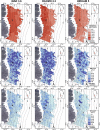Direct measurements of meltwater runoff on the Greenland ice sheet surface
- PMID: 29208716
- PMCID: PMC5740616
- DOI: 10.1073/pnas.1707743114
Direct measurements of meltwater runoff on the Greenland ice sheet surface
Erratum in
-
Correction to Supporting Information for Smith et al., Direct measurements of meltwater runoff on the Greenland ice sheet surface.Proc Natl Acad Sci U S A. 2018 Jun 26;115(26):E6097. doi: 10.1073/pnas.1809300115. Proc Natl Acad Sci U S A. 2018. PMID: 29941561 Free PMC article. No abstract available.
Abstract
Meltwater runoff from the Greenland ice sheet surface influences surface mass balance (SMB), ice dynamics, and global sea level rise, but is estimated with climate models and thus difficult to validate. We present a way to measure ice surface runoff directly, from hourly in situ supraglacial river discharge measurements and simultaneous high-resolution satellite/drone remote sensing of upstream fluvial catchment area. A first 72-h trial for a 63.1-km2 moulin-terminating internally drained catchment (IDC) on Greenland's midelevation (1,207-1,381 m above sea level) ablation zone is compared with melt and runoff simulations from HIRHAM5, MAR3.6, RACMO2.3, MERRA-2, and SEB climate/SMB models. Current models cannot reproduce peak discharges or timing of runoff entering moulins but are improved using synthetic unit hydrograph (SUH) theory. Retroactive SUH applications to two older field studies reproduce their findings, signifying that remotely sensed IDC area, shape, and supraglacial river length are useful for predicting delays in peak runoff delivery to moulins. Applying SUH to HIRHAM5, MAR3.6, and RACMO2.3 gridded melt products for 799 surrounding IDCs suggests their terminal moulins receive lower peak discharges, less diurnal variability, and asynchronous runoff timing relative to climate/SMB model output alone. Conversely, large IDCs produce high moulin discharges, even at high elevations where melt rates are low. During this particular field experiment, models overestimated runoff by +21 to +58%, linked to overestimated surface ablation and possible meltwater retention in bare, porous, low-density ice. Direct measurements of ice surface runoff will improve climate/SMB models, and incorporating remotely sensed IDCs will aid coupling of SMB with ice dynamics and subglacial systems.
Keywords: climate models; fluvial catchment; ice sheet meltwater runoff; surface mass balance; surface water hydrology.
Copyright © 2017 the Author(s). Published by PNAS.
Conflict of interest statement
The authors declare no conflict of interest.
Figures







References
-
- van den Broeke M, et al. Partitioning recent Greenland mass loss. Science. 2009;326:984–986. - PubMed
-
- Shepherd A, et al. A reconciled estimate of ice-sheet mass balance. Science. 2012;338:1183–1189. - PubMed
-
- Andersen ML, et al. Basin-scale partitioning of Greenland ice sheet mass balance components (2007–2011) Earth Planet Sci Lett. 2015;409:89–95.
-
- Enderlin EM, et al. An improved mass budget for the Greenland ice sheet. Geophys Res Lett. 2014;41:866–872.
-
- Chu VW. Greenland ice sheet hydrology: A review. Prog Phys Geogr. 2014;38:19–54.
Publication types
LinkOut - more resources
Full Text Sources
Other Literature Sources

